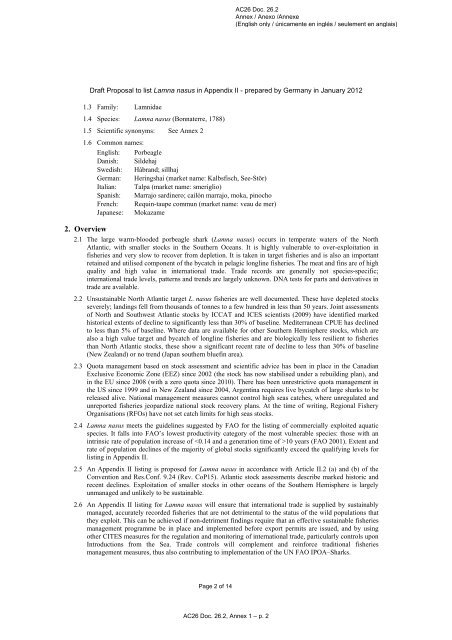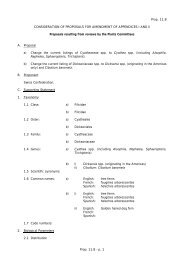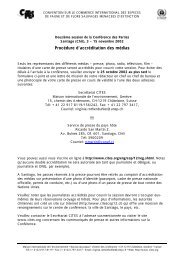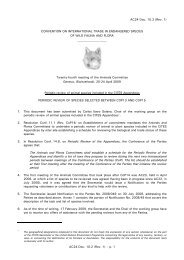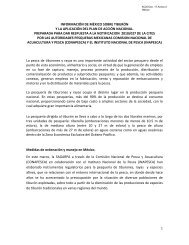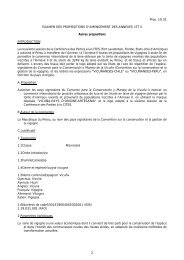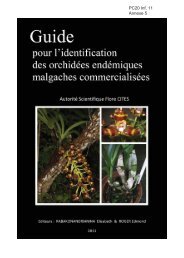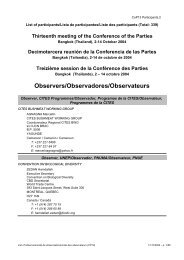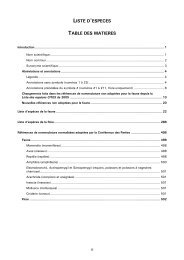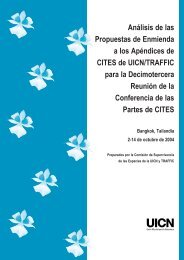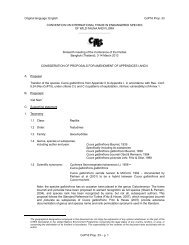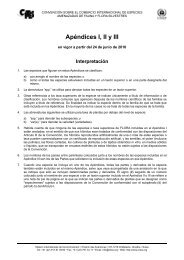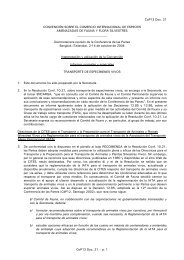Lamna nasus - Cites
Lamna nasus - Cites
Lamna nasus - Cites
You also want an ePaper? Increase the reach of your titles
YUMPU automatically turns print PDFs into web optimized ePapers that Google loves.
Draft Proposal to list <strong>Lamna</strong> <strong>nasus</strong> in Appendix II - prepared by Germany in January 2012<br />
1.3 Family: Lamnidae<br />
1.4 Species: <strong>Lamna</strong> <strong>nasus</strong> (Bonnaterre, 1788)<br />
1.5 Scientific synonyms:<br />
1.6 Common names:<br />
See Annex 2<br />
English: Porbeagle<br />
Danish: Sildehaj<br />
Swedish: Hábrand; sillhaj<br />
German: Heringshai (market name: Kalbsfisch, See-Stör)<br />
Italian: Talpa (market name: smeriglio)<br />
Spanish: Marrajo sardinero; cailón marrajo, moka, pinocho<br />
French: Requin-taupe commun (market name: veau de mer)<br />
Japanese: Mokazame<br />
2. Overview<br />
2.1 The large warm-blooded porbeagle shark (<strong>Lamna</strong> <strong>nasus</strong>) occurs in temperate waters of the North<br />
Atlantic, with smaller stocks in the Southern Oceans. It is highly vulnerable to over-exploitation in<br />
fisheries and very slow to recover from depletion. It is taken in target fisheries and is also an important<br />
retained and utilised component of the bycatch in pelagic longline fisheries. The meat and fins are of high<br />
quality and high value in international trade. Trade records are generally not species-specific;<br />
international trade levels, patterns and trends are largely unknown. DNA tests for parts and derivatives in<br />
trade are available.<br />
2.2 Unsustainable North Atlantic target L. <strong>nasus</strong> fisheries are well documented. These have depleted stocks<br />
severely; landings fell from thousands of tonnes to a few hundred in less than 50 years. Joint assessments<br />
of North and Southwest Atlantic stocks by ICCAT and ICES scientists (2009) have identified marked<br />
historical extents of decline to significantly less than 30% of baseline. Mediterranean CPUE has declined<br />
to less than 5% of baseline. Where data are available for other Southern Hemisphere stocks, which are<br />
also a high value target and bycatch of longline fisheries and are biologically less resilient to fisheries<br />
than North Atlantic stocks, these show a significant recent rate of decline to less than 30% of baseline<br />
(New Zealand) or no trend (Japan southern bluefin area).<br />
2.3 Quota management based on stock assessment and scientific advice has been in place in the Canadian<br />
Exclusive Economic Zone (EEZ) since 2002 (the stock has now stabilised under a rebuilding plan), and<br />
in the EU since 2008 (with a zero quota since 2010). There has been unrestrictive quota management in<br />
the US since 1999 and in New Zealand since 2004, Argentina requires live bycatch of large sharks to be<br />
released alive. National management measures cannot control high seas catches, where unregulated and<br />
unreported fisheries jeopardize national stock recovery plans. At the time of writing, Regional Fishery<br />
Organisations (RFOs) have not set catch limits for high seas stocks.<br />
2.4 <strong>Lamna</strong> <strong>nasus</strong> meets the guidelines suggested by FAO for the listing of commercially exploited aquatic<br />
species. It falls into FAO’s lowest productivity category of the most vulnerable species: those with an<br />
intrinsic rate of population increase of 10 years (FAO 2001). Extent and<br />
rate of population declines of the majority of global stocks significantly exceed the qualifying levels for<br />
listing in Appendix II.<br />
2.5 An Appendix II listing is proposed for <strong>Lamna</strong> <strong>nasus</strong> in accordance with Article II.2 (a) and (b) of the<br />
Convention and Res.Conf. 9.24 (Rev. CoP15). Atlantic stock assessments describe marked historic and<br />
recent declines. Exploitation of smaller stocks in other oceans of the Southern Hemisphere is largely<br />
unmanaged and unlikely to be sustainable.<br />
2.6 An Appendix II listing for <strong>Lamna</strong> <strong>nasus</strong> will ensure that international trade is supplied by sustainably<br />
managed, accurately recorded fisheries that are not detrimental to the status of the wild populations that<br />
they exploit. This can be achieved if non-detriment findings require that an effective sustainable fisheries<br />
management programme be in place and implemented before export permits are issued, and by using<br />
other CITES measures for the regulation and monitoring of international trade, particularly controls upon<br />
Introductions from the Sea. Trade controls will complement and reinforce traditional fisheries<br />
management measures, thus also contributing to implementation of the UN FAO IPOA–Sharks.<br />
Page 2 of 14<br />
AC26 Doc. 26.2, Annex 1 – p. 2<br />
AC26 Doc. 26.2<br />
Annex / Anexo /Annexe<br />
(English only / únicamente en inglés / seulement en anglais)


